OFF-ROAD 101
Bead Retention Tech (Beadlocks)
|
Beadlock: "A mechanical device that secures the bead of a tire to the wheel of a vehicle."
Many people, especially new off-roaders, have questions about what beadlocks (bead retention devices) are and how they might help them when off-roading. So here goes;
In normal driving conditions (out on the street), your tire is held tightly to the wheel by the air pressure within the tire, pushing the bead of the tire firmly against the lip of the wheel. For safety: When on the pavement and/or at highway speeds, you should always inflate your tires to your vehicle's or tire's recommended or "normal" highway pressures.
However, it is common to reduce tire pressures (PSI), sometimes substantially, when off-roading. Reducing tire pressures when off-roading can provide several benefits, including improved ride quality and traction. If you go off-roading (or want to) and are unfamiliar with airing down, you are getting a bit ahead of yourself by looking at beadlock wheels. Beadlocks are all about being aired down.
You can check out one of our posts on airing down, like this one: AIRING DOWN (SUMMER EDITION)
|
| Method Race Wheels (standard) Beadlocks |
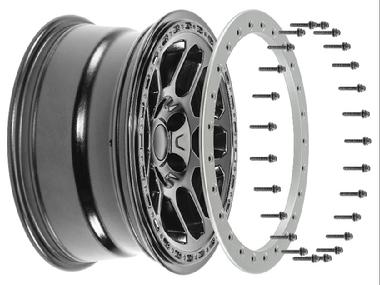 |
| Method Racing Wheels Beadlock Wheel |
|
|
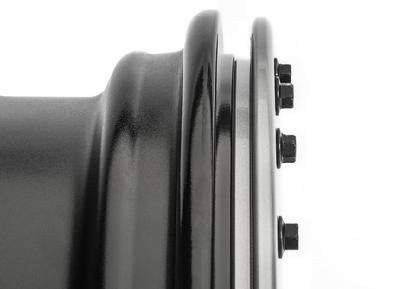 |
| Method Racing Wheels Beadlock Wheel |
|
|
The folks at Method Racing Wheels tell us that a beadlock wheel "relies on clamping force generated by tightening a set of bolts that thread into the wheel, applying force to the beadlock ring." The ring mechanically clamps and seals the tire's outer bead to the wheel." This effectively locks the tire and wheel together, so you cannot spin the wheel in the tire, and it dramatically reduces the chances of unseating that outer bead. While a less common occurrence, it does little to keep the inner bead seated as it only "locks" the outer bead. However, the inner bead generally experiances lower side pressures, so is less likley to de-bead than the outer side.
Tech Tip: This is the best known type of beadlock. There is such a beast as a "double beadlock" that effectively locks both beads, but they are not as common and can be very expensive. We will cover those and some other dual locking technologies later in this post.
A downside of standard beadlock wheels is that it requires regular maintenance and retorquing of the ring bolts for safety. People failing to maintain their Beadlock wheels properly is a primary cause of their reputation for being unsafe. If you do your part, they are very safe.
Another thing of note with beadlock wheels is the debate over whether they are "street legal" or not. Very few beadlocks are DOT Compliant. While I am unfamiliar with any Montana law against using beadlock wheels on the street, some other states are less friendly about them. Utah's vehicle inspection rules come to mind. In Utah, if your wheels are not DOT Compliant, they won't pass inspection. It is also best to remember that most (if not all) Beadlocks are designated as "For Offroad Use Only" by their manufacturers, even if they also claim their wheels to be DOT Compliant. This means many tire shops will not mount beadlock wheels due to both the additional work required and the liability potential.
To learn more, click here: Method Race Wheels Beadlocks
|
| REBOUND PRO INNERLOCK TECHNOLOGY |
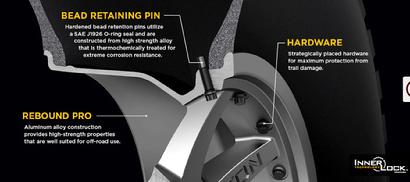 |
| ICON Alloys Rebound PRO |
|
|
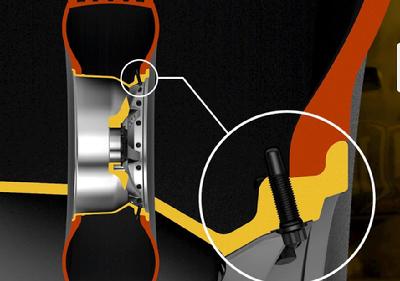 |
| ICON Alloys Rebound PRO |
|
|
An interesting (IMHO) alternative to the maintenance and possible legalities of standard "ring & bolt" beadlock wheels is Icon Vehicle Dynamic's "ICON ALLOYS REBOUND PRO WITH PATENTED INNERLOCK TECHNOLOGY" wheels. Whew...that's a mouthful. Icon has reimangined the beadlock.
Their patented method of locking the outer bead in place does not have the constant maintenance requirements nor any of the legality or liability issues of a traditional beadlock. Instead of using a metal ring, clamping the outer bead in place, Icon uses special bolts/pins installed behind the bead, effectively locking it in place.
They claim there are ZERO special maintenance requirements once set up correctly and that they are completely street-legal.
They say their technology is "an all-new way of capturing the tire bead and retaining it onto the wheel. InnerLock uses a series of O-ring sealed, hardened alloy pins that are inserted radially on the inner side of the tire bead to create a barrier that prevents the tire from unseating during extreme side loads. Additionally, InnerLock wheels are lightweight, strong, don’t require bolt retorquing, and are DOT compliant for the ultimate blend of on-road safety and off-road performance."
|
| Method Race Wheels "Patented Bead Grip® technology" |
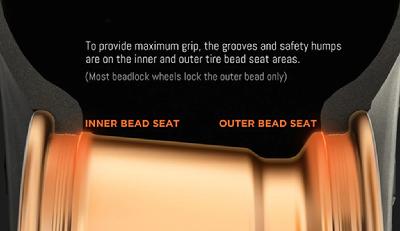 |
| Method Race Wheels |
|
|
 |
| Method Race Wheels |
|
|
Another intriguing option is the new bead retention technology from Method Race Wheels. They have redesigned the lip area of their wheels to secure BOTH beads of the tire better. Rather than the normal smooth bead seat, they have added a series of grooves to better secure the bead and an inner ridge to the inside to prevent slipping off the bead-lip. Method refers to this as their "Patented Bead Grip® technology."
Method Race Wheels states, "The integrated Bead Grip grooves, found on both the inner and outer bead seat, engage the tire bead for a stronger hold under extreme side load and lower air pressures. The wheel's 'safety hump' also gets a more aggressive profile which further stabilizes the tire bead in the seat."
This seems a really nice option, especially for the weekender in a daily driver. No issues with tires or tire shops, but they should have considerably better bead retention characteristics than standard wheels.
For more information on Method Race Wheels Bead Grip Technology, click here: Method Race Wheels
|
| Coyote Boltless Beadlocks |
 |
| Coyote Boltless Beadlocks |
|
|
 |
| Coyote Boltless Beadlocks |
|
|
Here is another great technology for securing a tire's beads, though it seems less well-known than the others. I am speaking about Coyote Enterprises' boltless inner beadlock system. No rings, no bolts, and they say, very low maintenance. It works with almost any off-road wheel (with a minor modification to the wheel), which seems a significant plus in its favor.
Coyote Enterprises tells us, "The Coyote Dual, Boltless, Internal, Pneumatic Bead Lock is a tire within a tire."
Since they fully lock both beads, you do not have to worry about burping or losing the inner bead. They are 100% street legal and, while not truly a run-flat technology, Coyote points out that these may allow you to "limp" back to camp or safety in the event of a flat tire. A close friend and very well-respected wheeler in Frontier 4x4 Club has run these for many years, and swears by them.
These were invented for the Swedish military in 1994 and have been in the US since being imported from Australia around 1996, so they have a sizable track record.
|
REVIEW:
BEADLOCK REVIEW: Coyote Internal Beadlocks - My one-year+ review:
Short version: Richard (me) likes them. Daryl likes them. Joe likes them.
Long version: (for those who have never commented "TLDR")
I am not one of those "these are great, I can't wait until they arrive in the mail" kind of reviewers. I really dislike those BS reviews and have little respect for those who post them. I am not interested in your opinion of the sales pitch; I am interested in how well they work.
So, here are my experiences and opinions on Coyote's internal beadlocks.
I installed a set a little over a year ago. We installed Daryl's set a few weeks later. We have both been running on our beadlocked tires since. I figure a year's worth of experience is a reasonable time for a real test and a solid review. Recently, Joe installed a set on his White Wrangler, too.
I'll start at the beginning (that always seems the best place to start):
Installation-
I am not going to say the installation was particularly easy. It was a bit of work. It would be nice if I could have had them installed for me, but one of the negatives of almost all beadlock technologies is that very few tire shops will install them. If you are unable or unwilling to do the work yourself (or trick your...uhhh...I mean ASK your friends to help), true beadlocks, internal or external, may not be for you. However, as we did more tires, it got easier and easier. We just had to learn some little tricks and techniques. The third set took us less time than the first wheel we did.
Running the beadlocks:
There are no tricks to running the internal beadlocks. Once correctly installed, they are pretty forgettable. I suggest occasionally checking the pressure of the inner beadlock (tube), but beyond that, they are more "set-and-forget." None of that constant retorquing of the ring bolts is needed.
Over many years and different sets/models/sizes of tires, I have run as little as 4 PSI (6 PSI is more common), when wheeling in deep snow hundreds of times. While I have debeaded a tire about 3 times over the last 20 years, it has not been something I was all that worried about. Still, having the Coyote Internal Beadlocks has been comforting. I no longer need to travel quite as slow or be as careful on side hills or when turning as is generally required for running low tire pressures without beadlocks.
Our group experience with these has been mostly uneventful. We did, however, have two occasions when having beadlocks made a clear difference.
On one occasion, Daryl's Jeep had to be spun around in the trail due to a mechanical issue. Several people were concerned that he needed to add air pressure before dragging the vehicle around so the beads would not break or burp. He was at around 5 PSI at the time. Daryl told them he was good, and rather than airing up and then back down once he got turned around, they spun his Jeep, and the beads held just as expected.
Another time, while down to 10 PSI, Daryl slid sideways into a ravine. He came to the bottom hard enough that he almost tipped, and we were all glad for the beadlocks. I have no doubt that it hit hard enough and at such an angle that he would have at least burped the front tire, if not debeading it altogether.
Pros:
You can use your existing rims (more often than not).
Lock both the inner and outer beads.
Relatively inexpensive (we all got ours during one of their 4-for-3 sales)
Requires very little maintenance after installation.
Have limited limp-flat capability.
Cons:
A PITA to mount.
Like most beadlocks, getting tire shops to mount/service them is rare.
Best for 10" or thinner wheels.
You have to drill a 2nd stem hole in your wheels.
I have had no issues with airing up or down. Both happen at about the same rate as before I installed the internal beadlocks. I did have one issue due to an installation goof on my part. Thanks to my error, I had to replace an air channel.
For me, airing down is not some kind of competition, so beadlocks are not about bragging about how little air pressure I can run. I only go as low as needed for the condition. What these do for me is add extra confidence about bead retention when I air way down, even when going a bit faster, turning, or being at steep side angles. Simply, they are comforting to have.
|
| Coyote Internal Beadlock REVIEW |
| Hutchinson Inc. Dual Internal Beadlock System |
Hutchinson Inc. offers an update to standard beadlocks with their excellent Dual Internal Beadlock System. by way of reference; it is the same system the military uses for all of their beadlock wheeled vehicles.
The Dual Internal Beadlock System utilizes a "beadlock insert" or sleeve to secure both beads to the rim, with a single set of studs holding both beads securely. The studs are not on the outer edge of the wheels as with traditional beadlock wheels, so they are far less susceptible to trail damage.
A nice touch is that Hutchinson's Dual Internal Beadlock System wheels are fully DOT compliant and street legal.
|
I hope the small amount of information helps you understand some of your bead retention options. Of course, each option has its pros and cons, and none is the perfect answer for all circumstances. There are also some other technologies and many manufacturers I did not mention. This is not, by any means, meant to be all-encompassing but just to give you a small idea of what is out there as you start considering your options for off-roading.
Face it, your average "overlander" is not going to need the Hutichinsons but they may be just the ticket for hardcore rock crawlers or racing rigs, just as examples. I saw several comments by people thinking the options I show here have similar prices. With a range from $848 to over $3400, prices do not seem all that "similar" to me. The costs below are for sets of 4 of their 17x8.5 on 5x5 wheels, or the Coyote Boltless Beadlocks for that size wheel. I am sure prices vary from place to place, so these are just for comparison.
Method 105 BEADLOCK (matte black) x4 = $1998.00
Method 701 Bead Grip (matte black) x4 = $1,426.00
ICON Rebound Pro (Satin Black) x4 = $1440.00
Coyote CEB17710-4 Boltless Beadlocks x4 = $848.00
Hutchinson D.O.T. Beadlock (Black) x4 = $3428.00
(*Average prices as of 1/1/2023)
I hope it is helpful to a few of you. Whether you just "want" them, truly needs them, or are just starting to explore the possibilities, these bead retention technologies can be a great tool and might offer a little peace of mind when off-roading, especially at lower pressures.
Wheel Safe!
|
The manufacturer trademarks and/or copyrighted graphics used here are only used to discribe the product or technolgy and are the property of thier respective owners. We do not claim nor imply any affiliation with, or sponsorship or endorsement by, the trademark or copyright owner.
|
|